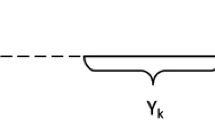Abstract
The sequential stochastic assignment problem (SSAP) allocates N workers to N IID sequentially arriving tasks so as to maximize the expected total reward. This paper studies two extensions of the SSAP. The first one assumes that the values of any two consecutive tasks are dependent on each other while the exact number of tasks to arrive is unknown until after the final arrival. The second extension generalizes the first one by assuming that the number of workers is also random. Optimal assignment policies for both problems are derived and proven to have the same threshold structure as the optimal policy of the SSAP.
Similar content being viewed by others
References
Albright SC (1974a) Optimal sequential assignment with random arrival times. Manag Sci 21(1):60–67
Albright SC (1974b) A Markov-decision-chain approach to a stochastic assignment problem. Oper Res 22(1):61–64
Albright SC (1976) A Markov chain version of the secretary problem. Nav Res Logist Q 23(1):153–159
Albright SC (1977) A bayesian approach to a generalized house selling problem. Manag Sci 24(4):432–440
Albright SC, Derman C (1972) Assymptotic optimal policies for stochastic sequential assignment problem. Manag Sci 19(1):46–51
Baharian G, Jacobson SH (2013a) Limiting behavior of the stochastic sequential assignment problem. Nav Res Logist 60(4):321–330
Baharian G, Jacobson SH (2013b) Stochastic sequential assignment problem with threshold criteria. Probab Eng Inf Sci 27(3):277–296
Derman C, Lieberman GJ, Ross SM (1972) A sequential stochastic assignment problem. Manag Sci 18(7):349–355
Derman C, Lieberman GJ, Ross SM (1975) A stochastic sequential allocation model. Oper Res 23(6):1120–1130
Gershkov A, Moldovanu B (2010) Efficient sequential assignment with incomplete information. Games Econ Behav 68:144–154
Hardy G, Littlewood J, Polya G (1959) Inequalities, 2nd edn. Cambridge University Press, Cambridge
Kennedy DP (1986) Optimal sequential assignment. Math Oper Res 11(4):619–626
Khatibi A, Baharian G, Kone ER, Jacobson SH (2014) The sequential stochastic assignment problem with random success rates. IIE Trans 46(11):1169–1180
McLay LA, Jacobson SH, Nikolaev AG (2009) A sequential stochastic passenger screening problem for aviation security. IIE Trans 41(6):575–591
Nakai T (1986) A sequential assignment problem in a partially observable Markov chain. Math Oper Res 11:230–240
Nikolaev AG, Jacobson SH (2010) Stochastic sequential decision-making with a random number of jobs. Oper Res 54(4P1):1023–1027
Nikolaev AG, Jacobson SH, McLay LA (2007) A sequential stochastic seceurity system design problem for aviation security. Transp Sci 41(2):182–194
Righter RL (1987) The stochastic sequential assignment problem with random deadlines. Probab Eng Inf Sci 1:189–202
Su X, Zenios SA (2005) Patient choice in kidney allocation: a sequential stochastic assignment model. Oper Res 53(3):443–455
Acknowledgments
This research has been supported in part by the Air Force Office of Scientific Research under Grant No. \(FA9550-15-1-0100\). Any opinions, findings, and conclusions or recommendations expressed in this material are those of the authors and do not necessarily reflect the views of the United States Government, or the Air Force Office of Scientific Research.
Author information
Authors and Affiliations
Corresponding author
Appendix: Proofs
Appendix: Proofs
Proof of Lemma 6
Using an approach analogous to that applied in equation (3.6) of Kennedy (1986), one can obtain
for any \(M \ge 1\) and \(n \ge 1\), implying that
and hence,
for any \(n \ge 1\) which results in
by (33) and the assumption that \(\sum _{i=1}^{+\infty }p_{i}<+\infty \). Now, observe that
where the second equality follows from (57) and the last equality is obtained since
where the first and the last equalities follow from the dominated convergence theorem and the second one is a direct result of the way \(\left\{ Z^{(1),N}_{m,n}\right\} \) and \(\left\{ Z^{(2),N}_{m,n}\right\} \) are defined in (9) and (10). Note that by Lemma 4 and the dominated convergence theorem,
for \(i=1,2,\ldots \), and observe that \(\left\{ {1 \over \alpha }\bar{Z}^{(1)}_{i,n}, i=1,2,\ldots \right\} \) is the set of ordered values of
which, by the extension of Lemma 3 (Hardy’s Theorem) to the infinite-support case (see Kennedy (1986)), implies that
By Doob’s forward convergence theorem, (60) and (65) indicate that the super Martingale \(\left\{ F^{\pi }_{n}: n\ge 1 \right\} \) converges almost surely to a finite limit \(F^{\pi }_{\infty }\) as \(n \rightarrow +\infty \), where
since
by (57), (33), and the assumption that \(\sum _{i=1}^{+\infty }p_{i} <+\infty \). Recall from (58) that
for any \(n \ge 1\), where the expected value of the right-hand side of (68) is finite, and hence, \(\left\{ F^{\pi }_{n}: n\ge 1 \right\} \) is uniformly integrable, which along with (65) yields
\(\square \)
Proof of Theorem 2
Using Lemma 6 and an approach similar to that applied in the final part of Section 3 in Kennedy (1986), the optimal assignment policy is derived as follows. For any fixed \(\pi \in \pi \mid _{1}\) and an arbitrary policy \(\phi \in \pi \mid _{n}\), by Lemma 6,
Therefore,
for any \(\pi \in \pi \mid _{1}\) and \(n \ge 1\). In addition, note that under policy \(\bar{\pi }\), (65) becomes
which leads to
where the inequality follows from (70). Recall that \(R^{\bar{\pi }}_{1}\) is the optimal expected total reward by definition; therefore, (72) implies that \(\bar{\pi }\) is the optimal policy. Moreover, the optimal expected total reward under \(\bar{\pi }\) is equal to
from (72) and the definition of \(F^{\pi }_{n}\). \(\square \)
Rights and permissions
About this article
Cite this article
Khatibi, A., Baharian, G., Behzad, B. et al. Extensions of the sequential stochastic assignment problem. Math Meth Oper Res 82, 317–340 (2015). https://doi.org/10.1007/s00186-015-0516-y
Received:
Accepted:
Published:
Issue Date:
DOI: https://doi.org/10.1007/s00186-015-0516-y



